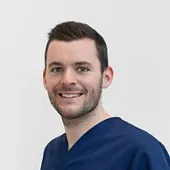Introduction
A Straumann® BLX SLActive® implant was used to complete the final restoration of the missing incisor. This type of surface technology allows us to reduce the healing time by up to 4 weeks and achieve a very predictable result.
Initial situation
A 63-year-old woman presented to our practice with the chief complaint of pain and discomfort in the area of tooth 21 (Fig. 1). She stated that the tooth had been treated approximately 30 years ago with a root canal treatment, followed by a metal post and crown restoration.
Orthopantomography showed that the patient had already received various dental treatments, including dental implants (Fig. 2). The patient’s medical history did not include any systemic or local diseases, and she was not taking any medications.
Treatment planning
Following the clinical and radiographic assessment, tooth 21 was diagnosed as hopeless, and tooth extraction was indicated (Fig. 3).
Conventional impressions were taken in order to prepare a removable/provisional prosthesis following the tooth extraction.
During the extraction procedure, a guided bone regeneration was planned in order to correct the horizontal bone defect caused by the infected tooth.
Following 7 months of healing, the insertion of a Straumann® BLX SLActive® implant was planned at this site, followed by the prosthetic procedures using a Variobase® abutment (Fig. 4).
Surgical procedure
The surgical procedures were carried out under local anesthesia, and tooth 21 was extracted because of external reabsorption and its compromised periodontal situation (Fig. 5).
During the procedure, a guided bone regeneration was performed using maxgraft® cortico-cancellous granules 1 ml, protected by permamem® (30x40 mm) non-resorbable d-PTFE membrane. A primary closure was not attempted, and the membrane was left exposed (Fig. 6). The surgical site was sutured with a 4/0 non-resorbable monofilament suture that was removed after 13 days of healing. On the other hand, the permamem® was removed 7 weeks after the extraction (Figs. 7,8).
Following 7 months of bone maturation (Figs. 9,10), a Straumann® BLX Ø 3.75/12 mm RB SLActive® Roxolid® implant was placed in the extraction site. In addition, the residual buccal bone defect was treated using a bone graft (Fig. 11).
Finally, the implant was connected with a transmucosal healing abutment, the flap was sutured with a 4/0 non-resorbable monofilament material, and a periapical radiograph was taken (Fig. 12).
Prosthetic procedure
The soft tissues had healed completely by 9 weeks after the surgical procedures (Figs. 13,14), and the final impression was taken (Fig. 15).
The dental technician made a zerion® UTML (monolithic zirconia) screw-retained crown that was glued, with PanaviaTM V5 (Kuraray Noritake), to a Straumann® Variobase® Ø 3.80 mm using a full digital lab workflow (Figs. 16,17).
Final result
The final crown was delivered 2 weeks after the impression (Fig. 18) and a control x-ray was performed (Fig. 19).
The patient was very satisfied with the final esthetic and functional result, and with the easy access of the interdental brushes that allowed correct oral hygiene (Fig. 20).
At the five-month follow-up, the peri-implant tissues were stable without any signs of inflammation.

